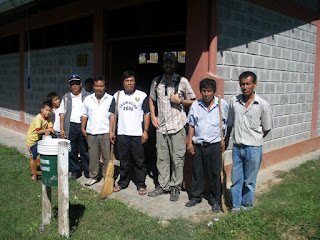In place of the study, I spent the majority of my time preparing for and delivering talks in two Amazonian indigenous communities located two hours by motorcycle from URKU headquarters in Tarapoto. Once Daniel, the head of URKU, found out I had taught environmental science, he asked me to speak with the communities about climate change. He is organizing a World Bank-funded climate change project and study in the communities, and he felt I could help URKU get a head start.
With the lapu (broom in hand), or mayor, and other community leaders in Colpa Sacha after they'd swept out the barn used as a community center where I would talk to 100-plus antzy primary school kids.
I struggled with the idea. “What can I say that would actually matter? They’re not the ones causing climate change. Aren’t there other, more pressing environmental challenges affecting their way of life?” In the end, though, I bought into the idea—the community needs to know what all the fuss is about, especially the kids. Also, I was told by one member of the Kawana-Sisa community that in the past mining industry representatives had lied to the community about mining risks and environmental consequences. Knowing some of the science could help fend off future attempts to deceitfully misinform.
I also decided to throw in my own tangential two cents. I was able to find a YouTube video to get this latter message across. The message: Through unified political activism, indigenous communities can make their voices heard, whether to fight environmental, health, or education problems. I joked with my mom the night before the presentation that I would be inciting revolt. We didn’t think the Peruvian government would appreciate the message I hoped to get across.
Instead of further reinventing the wheel, though, I have pasted an article I wrote for URKU (they want to inform the World Bank about our work in the communities) describing the visit we paid to the Colpa Sacha and Kawana-Sisa communities. But, before I do, I want to apologize for the length of the entry. Sorry!
Despite the small screen of the laptop, the small crowd of 15 gathered under the thatched roof was fully engaged. After the visitors’ presentation, with chickens and pigs scurrying around the dirt floor, the male-dominated audience told stories of the climate changes they’d observed firsthand and the pressure powerful oil companies were increasingly putting on the communities living on the hydrocarbon-rich land. They asked questions about the science and inquired about what all this talk of climate change and political activism means. Their refrain: “What can we do?” Throughout the meeting, the leader of the small group, a short, stocky man whose hardened feet went without shoes, sat at a table and, like someone who is intent on using what he is learning, took notes.

Like the Kawana-Sisa leaders, the other groups were as attentive to the videos and speeches as they were passionate when sharing their stories. By all accounts, the meeting’s goals—to equip the two communities with both a better understanding of climate change and a model for future activism—were met. The day’s nightcap and main event was no exception. Despite being pushed back by two hours due to an electricity outage (perhaps to be expected when the current has only been running for two months), young, old, and in-between formed a densely packed semicircle on the grassy knoll of Colpa Sacha’s main plaza for the delayed presentation. The community members stood silently, intently gazing up at the images on the white sheet turned projector screen. Somehow, like the glow from the LCD projector, but unlike the trend one sees in the mainstream news, the future of this Amazonian indigenous community seemed to shine a bit brighter as the night, increasingly darker, wore on.
The nightcap.
For URKU, though work has only begun with Kawana-Sisa and Copal-Sacha recently, this was familiar territory. The organization frequently ventures outside the confines of its Tarapoto office, further into the Amazonian river basin, and does work with indigenous communities. URKU specializes in studies of Amazonia’s biodiversity, but URKU founder and chief operator Carlos Daniel Vecco is intent on reaching out and sharing the organization’s scientific knowledge with those most intently connected to the land.
The small, muscular leader of Kawana-Sisa has plans to assemble a federation of local indigenous leaders to address their communities’ concerns. Colpa Sacha’s leadership team has made the two-hour trek to URKU headquarters to talk about strengthening their relations. The indigenous communities are hungry for more—more collaboration, more assistance, more visits. URKU is eager to satiate them.
To keep up with URKU’s projects, studies, and their relationships with the Kawana-Sisa and Colpa-Sacha communities, visit their website at http://www.urkuperu.org/.



No comments:
Post a Comment